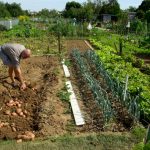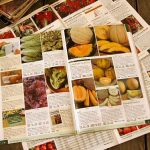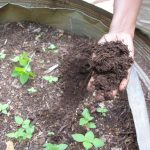Organic Gardening is Rising
Table of Contents
The above video features John Dromgoole, owner of The Natural Gardener,1 an educational organic gardening center in Austin, Texas. According to Dromgoole, Generation X’ers have become a driving force of his business. He’s seen a near 500 percent increase in vegetable, herb, and seed sales, for example, compared to previous years.
This is a very dramatic increase indeed, speaking to the rapid evolution of organic gardening—or perhaps it would be better to call it a rapid U-turn, back toward the age-old food production practices that we know works, and produces optimal benefits not just for you, but also for the environment.
This new wave of consumers, who are increasingly concerned about the quality of their food, are flocking to organic gardening centers to buy their produce and to learn how to grow their own food. Dromgoole’s nursery also teaches people how to address problems like pests and weeds without resorting to chemicals.
What Dromgoole calls “square-foot gardening” is also increasing in popularity, as more and more people take to growing their own food, no matter how much, or how little, space they have.
By using a grid-space, you can increase the amount of herbs and vegetables you grow per square foot, compared to sowing them in long beds, as was typically done in the past.
The Answer to Many of Our Problems is Urban Gardening
There is no doubt about the fact that urban gardening or farming is a crucial step toward achieving a more reliable food system that will stand the test of time. As a matter of fact, I’ve been promoting this practice by encouraging individuals to have a ‘Victory Garden’ as a fast way to revitalize our broken food system and improving our general well-being.
It is called Victory Gardens because 40% of the produce gotten during war era in the US was from individuals’ subsistence farming done at their backyards. I really think it won’t be absurd to make similar move for a different goal. Talking in reality, most people think it is very hard to get superb nutrient-filled foods except one grows them by oneself.
I agree with you that food grown in your own garden tastes better, 100% fresher and more nutritious than food purchased from a store, even the price is unbeatable!
Urban gardening is also a key to save more energy, protect water quality and topsoil, promote biodiversity and also to beautify highly populated regions.
It might even be a turn-around we need so as to be able to reduce the rate of depression to the nearest minimum, among some of our people, much of which may be connected to the feeling of being restricted from nature, which in turn has created a gap between the privilege few and the rest people.
A report on survey carried out by the Gardeners’ World Magazine showed that 80 percent of gardeners are “happy” and satisfied with their standard of living, compared to 67 percent of non-gardeners. Monty Don, a TV presenter and garden writer, characterized the well being of gardeners to the “recharging” they get from putting their hands to work on soil frequently and spending much of their time outdoors in nature.
This sounds beyond reasonable when you evaluate the health benefits accrued to grounding, also called Earthing. As explained in the documentary film ‘Grounded’, the Earth surface is endowed with some unnoticeable health-boosting energy, so all you need to do is to touch it.
When you walk barefoot on the Earth surface, electrons are transferred freely from the Earth’s surface into your body that spread throughout your tissues. Grounding has been proven to improve sleep, relieve pain, minimize inflammation and promote your well-being. Many gardeners will as well testify to the sense of wellness gotten from sticking their hands in the dirt, This is not part of the pleasure of achievement they get from eating their own home-grown food.
Start a Garden in this year!
Apart from having an increase in your sense of well-being, you can also enhance your health when you keep a garden by providing for yourself fresher, uncontaminated and nutrient-rich foods that are not available in your grocery store. It will also assist you to cut down on your grocery bill. You don’t need an expanse of land to get started. An apartment dweller can build a well-stocked edible garden.
You can grow food using virtually every square foot of space available to you, even your lateral space is useful too. Hanging baskets are suitable for different kind of crops, such as leafy greens, strawberries, tomatoes, runner beans, pea shoots and different kind of herbs. Window boxes are ideal to hold herbs, scallions, chard, greens, radishes, bush beans, strawberries, and chilies.
Just start on a small scale, and as you make progress doing it, add another container of something different. Should you care to learn more, please see my previous write-ups on creating edible gardens in small spaces. As you continue to work on your garden tirelessly, you’d be amazed that large portion of your meals could come from your edible garden. I will also recommend that you get your feet wet by growing sprouts.
Not only does sprouts have a rapid reward by producing food ready for harvest within one week, but also the most nutritious foods you could grow, enriched with up to 30 times the nutrients of organic vegetables.
Sprouts give room for your body to extract more of the vitamins, minerals, amino acids, and essential fats from other foods you eat. Adding more point to the fact that it requires very little space to cultivate and the ability to grow them indoors throughout the year, they really do not have shortage of benefits.
Instead of growing them in Ball jars, I recommend you grow them in potting soil. They will be due for harvest in about 7 days time. In a 10by10 tray, you can harvest between one and two pounds of sunflower sprouts. This will take you for about three days.
They could be stored in refrigerator for about a week. I’ve been growing sprouts for over a year now, and most times use sprouts in lieu of salad greens. Sunflower sprouts will give you the highest volume for your work and, in my own opinion, have the best delicious taste.
Pay Attention to Your Zoning Laws
Unfortunately, a not-so-subtle war has been waged against American homeowners who want to plant gardens on their own property. Legal codes that outlaw planting vegetables on a large percentage of your yard, or restrict them to only certain areas like the backyard, out of view of the public, truly defy common sense—especially considering the negative impact lawns have on the environment.
In many instances, zoning laws are simply outdated and out of step with today’s world. Still, they can lead to frustrating legal headaches if you fail to heed them. It’s important to realize that every city has different laws and ordinances, and there are no standards spanning jurisdictional lines.
So, while I strongly encourage you to get involved in growing your own food, please do remember the preliminary step of finding out what your zoning laws allow. There are often restrictions governing the raising of goats, chickens, bees, and even where you can plant a simple vegetable garden. If you find the zoning laws prohibit or restrict gardens in your area, I would encourage you to get involved at the local level to change those ordinances. Not only will it benefit you—it could promote positive change for hundreds of families… Below are a few organizations and resources that may be of assistance:
| American Community Gardening Association (ACGA) – Devoted to community gardening and greening up communities across the nation. The organization has local chapters across the country. |
| Sustainable Cities Institute – Research and innovation about how to make cities more sustainable, including planning and zoning for urban agriculture |
| Practice Urban Agriculture (March 2010) – Information about urban agricultural zoning; lists a good number of government initiatives, plans, and ordinances that are up for vote in the near future |
| Food Not Lawns – A sustainability movement focused on getting rid of lawns in favor of more ecofriendly alternatives; also has chapters in nearly every state across the country |
| Lots 2 Green – Provides technical assistance to communities in order to facilitate their using vacant lots and other urban properties for community gardens and farms |
Agriculture Supported Communities at the Rodale Institute
The Rodale Institute is another wonderful resource for anyone interested in organic gardening. An organic garden is a great way to promote honeybees, and both flower and vegetable gardens provide good honey bee habitats. Small-scale beekeeping is also gaining in popularity—yet another sign that people are taking both their food and their environment more seriously, and are recognizing the fundamental, if not downright sacred, link between man, nature, and food.
Many are familiar with the term “Community Supported Agriculture,” or CSA, but Rodale’s ASC program works a little differently. Instead of taking a lump sum from their customers up front, they go into underserved communities that have neither lots of money nor easy access to organic food, and offer a pay-as-you-go, weekly shareholder’s agreement. They even accept government assistance checks. So each week, organic food harvested at the Institute is brought into communities such as Reddington, Bethlehem, and Allentown, PA. At present, the program feeds about 150 families in these areas.
They also teach these customers how to prepare the fresh foods they’re getting, and when there’s excess produce, the Institute offers classes on canning and preservation.
How to Find Locally-Grown Foods
Besides growing your own, joining a local CSA and/or frequenting local farmers’ markets are great ways to procure farm-fresh, local foods, year-round. Here are some resources that will help you find local farms, markets, CSAs, and more:
Local Harvest — This Web site will help you find farmers’ markets, family farms, and other sources of sustainably grown food in your area where you can buy produce, grass-fed meats, and more.
Alternative Farming Systems Information Center, Community Supported Agriculture (CSA)
Farmers’ Markets — A national listing of farmers’ markets.
Eat Well Guide: Wholesome Food from Healthy Animals — The Eat Well Guide is a free online directory of sustainably raised meat, poultry, dairy, and eggs from farms, stores, restaurants, inns and hotels, and online outlets in the United States and Canada.
FoodRoutes Network — The FoodRoutes “Find Good Food” map can help you connect with local farmers to find the freshest, tastiest food possible. On their interactive map, you can find a listing for local farmers, CSAs, and markets near you.
Source: articles.mercola.com


















